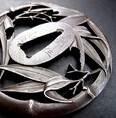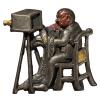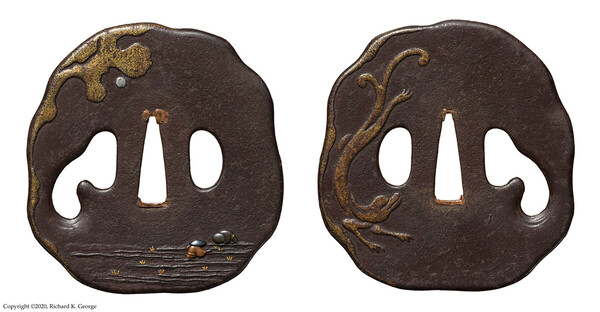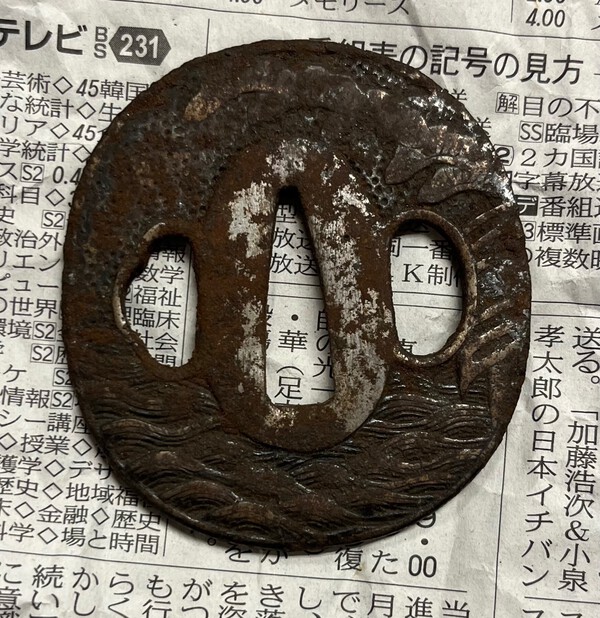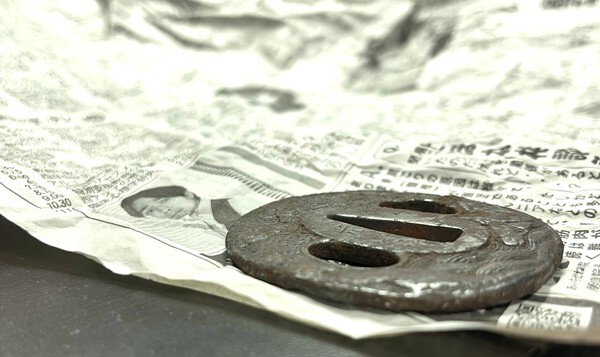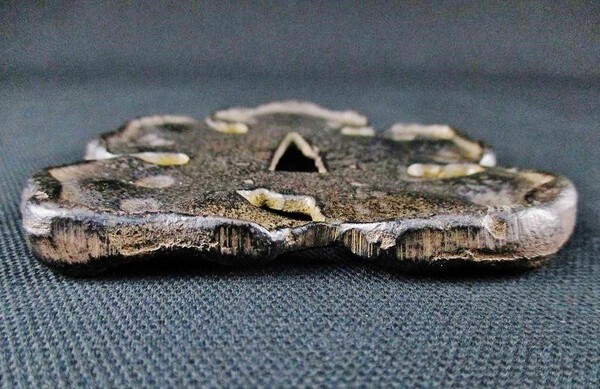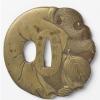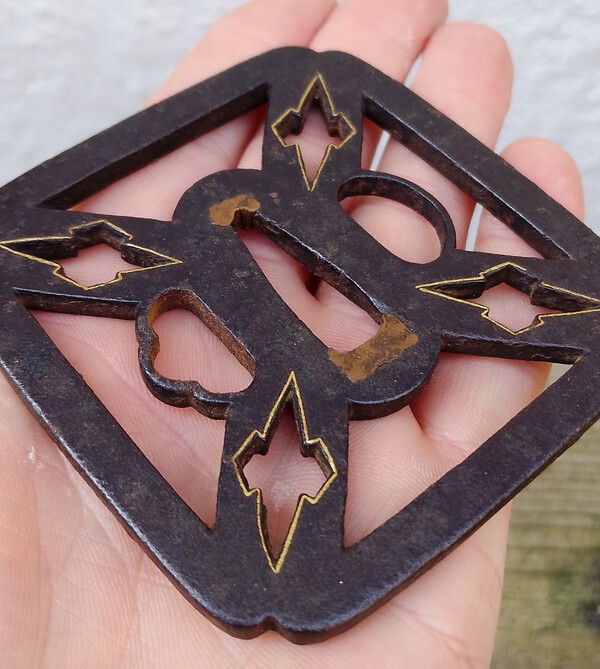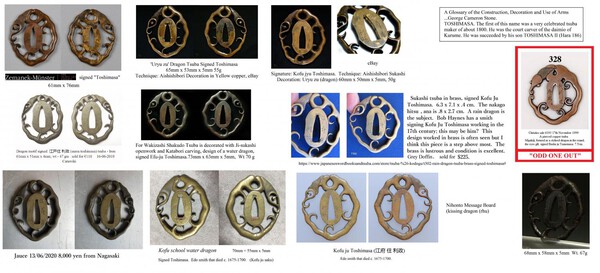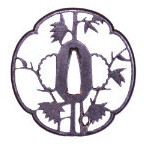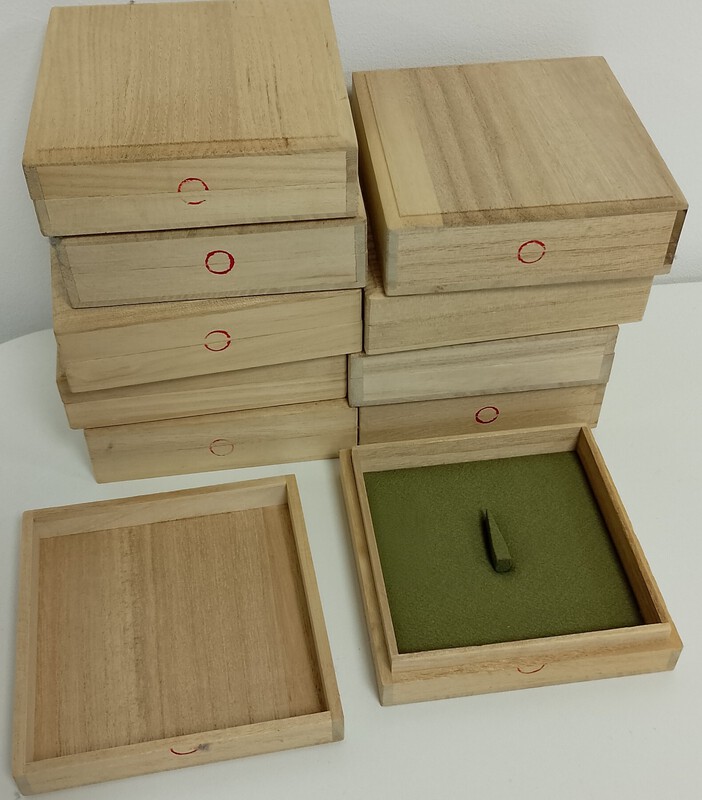Search the Community
Showing results for tags 'tsuba'.
-
Just a quick public notice. I will be giving a PowerPoint presentation at this coming club meeting of the New York Token Kai on Sunday, December 7, 2025, from 12:00 PM to 3:00 PM, titled: "Reflections on 25 Years of Collecting Japanese Art". Check out more information about the club here on their website: https://www.ny-tokenkai.org/. After the presentation I will try to covert my presentation into a noneditable file format that will allow me to share it on my website here: Tsuba Otaku | Reflections of a Not So Empty Mind. Thank you.
-
Hello! Tsuba - bamboo tree. 1000 euros. Material is iron Mei/signature: 東都住貞恒 Toto Ju Sadatsune, Period/era: Edo, Certificate: None, Measures: 7.8 cm x 7.3 cm x 0.40 cm. Location: Germany, Berlin. Payment via PayPal or in person in Berlin. Alexander
-
Hi, I am trying to write a description for one of my tsuba, and am having trouble determining what the meaning of the decorations are. I think the piece is Jakushi work (though we'll never know for sure because its not signed - had to have been somebody in the Nagasaki area though). One side shows a rain dragon (thanks Gordon/others), and the other shows workers who are apparently planting rice. They seem to show the cloud the rain dragon is from wrapping around the piece, suggesting this is some kind of unified theme. So... is there a legend or standard name for this or is it just a "rain dragon/rice planting themed tsuba"? Apologies if you've already seen this - I've posted it in another forum or three as well. Thanks in advance, rkg
-
Hi, everyone, I was browsing my go to auction site for some bits n pieces unrelated to nihonto and stumbled upon a seller who is offering mostly WW2 Japanese military stuff, in description he states that items are either imorted form Japan or from his personal collection, but whatever. What I found is quite nice tsuba, seller states in the description that it is 20th century, fair enough could be. I just wanted some opinions of the amazing people here what do you think? Does it look authentic? Is it really Meiji era tsuba or otherwise? I mean it looks really nice so even if it was contemporary i would probably get it. It is priced around 40 Euros. Any opinion is welcome. Best regards, Martin
-
Dear all I am parting with a nicely made Edo period pine sukashi tsuba. Dimensions: 7.88 cm x 7.64 cm Height: 0.52 cm Seppa-dai (max): 2.99 cm x 0.85 cm Asking price: EUR 300.00 plus shipping Best Chris
-
A recent auction purchase that I took a chance on as it was described in the catalogue as 'A modern reproduction of a late 19thC Japanese cast metal tsuba'. I had studied the auctioneers pictures and I was pretty sure it wasn't a modern copy as I could see nunome-zogan, the sekigane around the seppa dai and hitsu ana looked like good copper inserts, the figures on the bridge looked typical of ones I have seen on other tsuba and it appeared to come with an old higher spec custom box. I'm no expert here and I may be totally wrong but now I have it in hand it looks authentic? Dimensions: Height 85.5mm Width 83.0mm Seppa dai 5.1mm Mimi with gold fukurin 5.2mm There's a few questions if you don't mind: The hitsu ana seem unusual for Soten compared to others I have looked at, is it Soten or in the style of? It doesn't look to have been mounted, and again the large sekigane for the hitsu ana I've not seen before, is this unusual? Having looked at Japanese paintings on-line to try determine the scene or tale it represents nothing jumps out with three travellers/sages admiring the mountain view with shrine/temple in the distance, any thoughts or is it just a nice scene? Thanks for looking and welcome any feedback.
-
$100 or best offer. This listing features the scarce and important reference work Tsubas in Southern California, compiled and published by renowned Japanese arms scholar W. M. Hawley. This catalog-style volume documents a wide range of tsuba (Japanese sword guards) from private and institutional collections in Southern California, offering a visual and descriptive survey of fine sword fittings. Compiler/Publisher: W. M. Hawley Title: Tsubas in Southern California Publication: Self-published, 1973 Language: English Binding: Hardcover Contents: Numerous black-and-white photographs and brief descriptions of 1,419 antique tsuba from various schools and periods Lower United States only. Subject to being sold earlier. Very good condition.
-
$40 or best offer. This is Joly and Tomita's vast and beautifully illustrated book on Japanese art. Sword fittings comprise more than one half of the book and are of the highest quality with descriptions in English. Prints, netsue and lacquer are also covered in text and photographs. Primarily black and white photographs are offered, with some color plates. This copy is in excellent condition with its original slip-case and dust jacket. This 1976 reprint of the original 1916 edition was printed in England on heavy stock and is an amazing and extensive overview of Japanese art and particularly sword fittings. Lower United States only. Subject to being sold earlier.
-
Hello, My name is Brian and I have just gotten into tsuba collecting. I recently picked up two pieces from a flea market in Japan and would greatly appreciate help identifying and verifying the tsuba. The first tsuba has a mei, does anyone recognize it? Any suggestions or advice would be greatly welcomed. Thanks,
-
-

Looking for specific Tsuba. Do you have something like that?
2devnul posted a topic in Wanted to Buy
Hi, I'm looking for Tsuba for Wakizashi. Something like below example. Mokko Gata with Shakudo. Anyone? -
This subject has been discussed previously as far back as 2011, but just a short update on the growing number of these "tsuba" to use a word very loosely. I have added an often neglected view showing the bottom edge where the giveaway casting marks are often found. Collectors should be made aware of these often high priced 'Paper weights'. I continue to collect images of these things as they continue to pop up, there are a few right now on auction sites so have a real close look when you buy.
-
Dear all, Some estimated NMB members have decyphered this tsuba signature as being : right side: 癸巳十月 left side : 心哉彫 Unfortunatly nobody as a smith is referenced with these kanji in books which are available to me. Does someone can find similar tsuba in style to drive me in the right direction ? Thank you.
-
-
- 1
-

-
I recently purchased this tsuba on ebay, can anyone tell me anything about it? I'm new to this whole sword and fitting thing so any help is appreciated.
-
Dear all, I recently got a tsuba that I aesthetically really loved with what I believe is quite clearly a Daruma motif. It is rather larger in size (at approx. 90 mm dia) and is made of iron with hon-zogan depicting the head and what seems to be gold leaf hammered into the iron base depicting the body silhouette. For its size it does not feel too heavy although it is made of iron (tried it with magnet). No signature. Please see the image below. My question, with which I wanted to dig into the wealth of knowledge among the many wonderful people within this forum, is: would anyone have any idea about origin (what school) and potential age of this tsuba? Basically I have not really seen anything similar to this before (in real life or in literature) so I was wondering if someone has seen anything like this and would have any suggestions or opinions. Wishing you all a very lovely weekend! Lukas
-
Back before the world went Covid, in 2019 Leon Kr posted a thread http://www.militaria.co.za/nmb/topic/30455-help-needed-with-mei/ That he never really got a straight answer to. I believe because at the time it was dismissed as 'oh no not another cast copy'. Well having just stumbled upon it, I thought to clarify a rather muddy topic. I am normally on the look out for mass produced copies and have posted a few threads on this subject - however this time I would like to show a collection of mass individual pieces 'utsushi' I would guess. From my research there are quiet a range of metals used in their construction but they tend to have three distinct features either a full signature. A partial signature. Or are not signed. The design is always the same but I have yet to see any, that are an exact copy of another. The signatures according to the various owners or sellers usually state to be 'Toshimasa' - Then it gets mixed up - Kofu ju Toshimasa, Kofu jyu Toshimasa, Sumu Toshimasa and the book by the members of the 'Japanese sword society of New York' 1966 describe the maker as 'Mitsunobu (Bushu {Musashi} Province) yet apart from the last, the Kanji is all the same? Toshimasa had several designs, Leon Kr's 'Waves and Birds' also becomes 'Waves and Maple leaves'. Then there is the Dragon - Rain dragon, Smooth dragon, Serpentine dragon, Water dragon, Kissing dragon - no one knows and does it really matter! The point is they are not cast copies. ps. There were several 'Toshimasa' including a father and son - take your pick because your guess is as good as anyone elses!
-
I recently purchased this tsuba and whilst the mei is a standard Kaneie I believe it's probably an Aizu Shoami copy in the 'style' of Kaneie. What I'm unable to figure out is the theme of the tsuba. It looks to be a group of stylised people on the front either side of a path or road, with possibly trees? On the reverse, again it appears to be groups of people near a path or road but this time there is a pole with ropes with flags/banners? on it. I thought possibly a Shinto festival but a search hasn't revealed anything that looks similar. I may be well off but your thoughts would be most welcome. Dimensions: H: 70.0mm W: 69.0mm Mimi: 3.75mm Seppa dai: 4.35mm One small piece of inlay missing on the back at 5 o'clock but interestingly the original left a gap in the inlay for the seppa here.
-
I've been trying to identify the school for this one, a common theme of tea ceremony utensils. Dimensions below: Shape: Nagamaru-gata Mimi: Maru-mimi Height: 69.5mm Width: 65.5mm Mimi thk: 4.65mm Seppa dai thk: 4.85mm Nakago ana: 23mm x 7mm I thought possibly Choshu or Kinai but not too sure, hence the question. At one point I even thought Akasaka but I don't think it's a theme this school would have used. Any thoughts welcome.
-
For sale an iron Akasaka style Yatsuhashi tsuba, with unusual hammer finish (ishime-ji or arashi-ji), not corrosion. Asking £150 + shipping. Details below: Maru-gata Maru mimi H: 75mm W: 75mm Mimi: 6.1mm Seppa dai: 6.45mm Nakago-ana: 25.5mm x 7.5mm
-
With the help of Curran, I have been studying the only tsuba I have that has a mei. It is made by Kazunori, who was a likely student of Shodai Norisuke and a contemporary of Nidai Norisuke based on Curran's expert speculation. The masters of this school were renown for their utsushi-mono of Nobuie, Yamakichibei, and Yagyu, as well as tsuba in their own distinct style. There is only one other that I have seen with a mei that has Kazunori (一則) engraved on the left side (Owari To Mikawa No Tanko, page 59). Mine has additional engraving on the right side to complete the name Kazunori Obu-Ju (尾府住一則), which clearly identifies him as a smith working in Owari Province. This piece is circa 1830s or 1840s when Shodai and Nidai were making tsuba with carving that wrapped over the mimi (so-called daki-moyo stye). My full write-up is attached. Owari To Mikawa No Tanko (page 59) Norisuke school Kazunori Obu Ju (Arabesque and Wickerwork.pdf
-
Dear collectors and readers interested in Tsuba, I am parting with a significant part of my collection so please feel welcome to buy or make an offer on the items shown. Kyo-Shoami - NBHTK Hozon certificate- 1100 € Higo - probably Nishigaki - 320 € Tosa Myochin - 650 € Heianjo Sukashi - 1700 € Akao - water well - 350 € Akasaka - Chrysanthenum - NBTHK Hozon certificate - 700 € Akasaka - Sugawara Denju Tanarai Kagami - 450 € Akasaka - Pine, Karigane, Moon - NBTHK hozon certificate - 750 € Akasaka - Stick figure - 500 € Kyo Shoami - Itomaki Hanabishi - NBTHK Hozon certificate - 600 € Late Edo Owari - 150 € Kyo Shoami - Take Bamboo - 450 € To reduce traffic on the board - more pictures only on request by pm. Shipping from France or Germany at best rates - typically the next day. (example: US ships for 22,50€, Europe 14,00€, France and Germany: free) Best wishes, Tobi
-
This is a recently acquired Kanayama tsuba "study piece" costing just over $300 on a Jauce auction. It has a massive seppa-dai and large lump-type tekkotsu concentrated on the upper mimi clockwise between 7 o' clock and 1 o' clock (two are shown in pic). There is a slight dishing from mimi to seppa-dai. This is a genuine Kanayama, but has some unusual variant features. The motif on the left and right of the seppa-dai and forming the hitsu-ana is often referred to as "sea cucumber" (namako) and made famous by the tsuba of Miyamoto Musashi. However, I highly doubt that he was thinking of a deep sea creature to decorate a sword fitting when he adopted this abstract motif as part of the simple and symmetric composition commonly found in Kanayama tsuba. This tsuba is almost certainly a product of the Momoyama Period with a lively flow of curves in the composition that is mesmerizing and evocative of Wabi Tea and Zen Buddhist aesthetic principles including wabi, sabi, and mono no aware. For me it is also an especially powerful evocation of yugen (mystery). Beyond the tekkotsu there is variation in thickness going around the mimi and the seppa-dai, which exaggerates the rustic spirit of the overall effect. The surface has an unusual appearance comprised of an exaggerated and coarse cobblestones/craters (not sure if it can be described as tsuchime-ji) interrupting a beautiful yakite-shitate surface treatment. This seems to be an intentional aesthetic expression rather than reflecting any corrosion of the patina, which has a lovely color. There is an almost identical example of this tsuba in "Openwork Tsuba" by Kenichi Okubo, et al (page 192) that is more of a classical Kanayama tsuba in its features. The major differences are that the width of the motifs on either side is even less uniform in my tsuba, being thinner at the center so as to create almost the appearance of upper and lower lobes, it has a massive seppa-dai measuring 47 x 27 mm (reminiscent of Ko-Shoami), and it has an unusual linear gouged tagane pattern around the entire nakago-ana. It appears to have been mounted many times, which may attest to the aesthetic value placed on this tsuba. There are a few other similar pieces found on my Google search, but they are linked to NMB posts that apparently no longer exist. The major differences are whether there is a kogai hitsuana or if both are kozuka hitsuana, and whether the curved element that forms the hitsu-ana is joined to the mimi in a more round shape (relaxed), such as in my tsuba, or at a more acute angle (stiff) as in the reference piece below. Diameter: 76 mm Width: 5.7 (mimi), 5.0-5.3 mm (seppa-dai) Weight: 97 gm
-
-
There is a nice openwork tsuba book on Jauce that the seller won't ship internationally. Any members of the community who lives in Japan or knows of someone in Japan who would be so kind as to assist with shipping it to me in Florida after Jauce ships it locally within Japan? Fully at my cost of course. Thanks in advance. Steve



